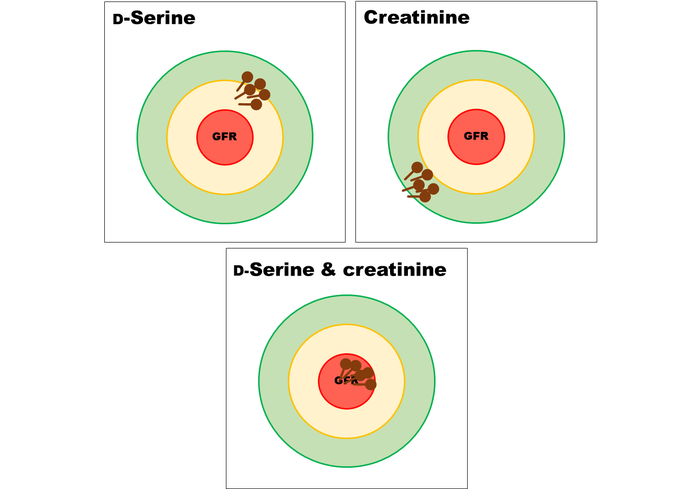A team of researchers led by the National Institutes of Biomedical Innovation, Health and Nutrition (NIBIOHN) and Osaka University established a new method to measure glomerular filtration rate (GFR), a primary kidney function, by calculating the clearance of D-serine.

Credit: Tomonori Kimura
A team of researchers led by the National Institutes of Biomedical Innovation, Health and Nutrition (NIBIOHN) and Osaka University established a new method to measure glomerular filtration rate (GFR), a primary kidney function, by calculating the clearance of D-serine.
The research group evaluated the clearance of D-serine when assessing GFR through the inulin clearance measurement in living kidney transplant donors and recipients. Consequently, they found that the D-serine clearance strongly correlated with GFR and was less biased than the creatinine clearance, a conventional marker for renal function.
Chronic kidney disease is a global problem, and its frequency is increasing with the aging population. Evaluation of GFR is essential for better clinical practice to reduce the number of dialysis patients; however, the current evaluation of GFR has several limitations, including a labor-intensive procedure for the inulin clearance, the gold standard of GFR, a major bias for the creatinine clearance, and imprecise estimation of estimated GFR (eGFR). Endogenous molecules potentiating the precise assessment of kidney function with low biases are still necessary for important clinical decisions, including drug administration design, transplant donor selection, and staging of kidney disease.
L- and D-amino acids are mirror-image enantiomers, and L-amino acids are exclusively present in the human body. “A trace amount of D-serine is present in human blood and reflects kidney function,” says study lead author Masataka Kawamura. He says “We are investigating the potential of D-serine for the precise assessment of kidney function.”
The research group evaluated the urinary excretion rate (clearance) of D-serine in living kidney transplant donors and recipients. The clearance of D-serine was calculated based on the D-serine levels in the blood and urine that, measured using a two-dimensional high performance liquid chromatography system, which is the most accurate and sensitive system for measuring D-amino acids.
Remarkably, the clearance of D-serine agreed well with GFR. The low bias as a measure of GFR was an advantage for the D-serine clearance. The degree of bias against GFR was smaller than that of the creatinine clearance. Additionally, the combinational analysis of clearances of D-serine and creatinine could measure GFR with high performance.
“D-Serine turned out to be of great clinical importance,” says the study senior author of the study, Tomonori Kimura. According to him, “D-Serine may solve the problem of kidney disease with more than 800 million patients in the world. Measuring D-serine is applicable in a wide range of clinical fields and for drug development.”
###
The article, “Measurement of glomerular filtration rate using endogenous D-serine clearance in living kidney transplant donors and recipients” was published in EClinicalMedicine at DOI: https://doi.org/10.1016/j.eclinm.2021.101223 on December 6, 2021 (Japanese time).
About Osaka University
Osaka University was founded in 1931 as one of the seven imperial universities of Japan and is now one of Japan’s leading comprehensive universities with a broad disciplinary spectrum. This strength is coupled with a singular drive for innovation that extends throughout the scientific process, from fundamental research to the creation of applied technology with positive economic impacts. Its commitment to innovation has been recognized in Japan and around the world, being named Japan’s most innovative university in 2015 (Reuters 2015 Top 100) and one of the most innovative institutions in the world in 2017 (Innovative Universities and the Nature Index Innovation 2017). Now, Osaka University is leveraging its role as a Designated National University Corporation selected by the Ministry of Education, Culture, Sports, Science and Technology to contribute to innovation for human welfare, sustainable development of society, and social transformation.
Website: https://resou.osaka-u.ac.jp/en
About National Institutes of Biomedical Innovation, Health and Nutrition (NIBIOHN)
The National Institutes of Biomedical Innovation, Health and Nutrition (NIBIOHN) was established in April 2015 by merging and reorganizing the National Institute of Biomedical Innovation (NIBIO) and the National Institute of Health and Nutrition (NIHN). The goal of NIBIOHN is to support the development of innovative pharmaceutical and medical products in Japan and to improve the health and wellbeing of the Japanese population through surveys and studies on hygiene, nutrition, and diet.
The Center for Rare Disease Research (CRDR) was established in 2017 as a platform for rare disease research and development. CRDR is a national center for the advancement of nation-wide research on rare diseases. CRDR is an intellectual, technological, and informative hub for rare disease researchers that propels an industry-academia-government-clinic cooperation.
Website: https://www.nibiohn.go.jp/en/
Journal
EClinicalMedicine
DOI
10.1016/j.eclinm.2021.101223
Method of Research
Observational study
Subject of Research
People
Article Title
Measurement of glomerular filtration rate using endogenous D-serine clearance in living kidney transplant donors and recipients
Article Publication Date
6-Dec-2021
COI Statement
A part of this study was funded by Shiseido Co., Ltd and KAGAMI Inc. TK has an equity in KAGAMI Inc. TK is an inventor on issued and applied patents (WO2020080484A1, PCT/JP2020/048977), which are related with this work. All other authors declare no competing interests.




